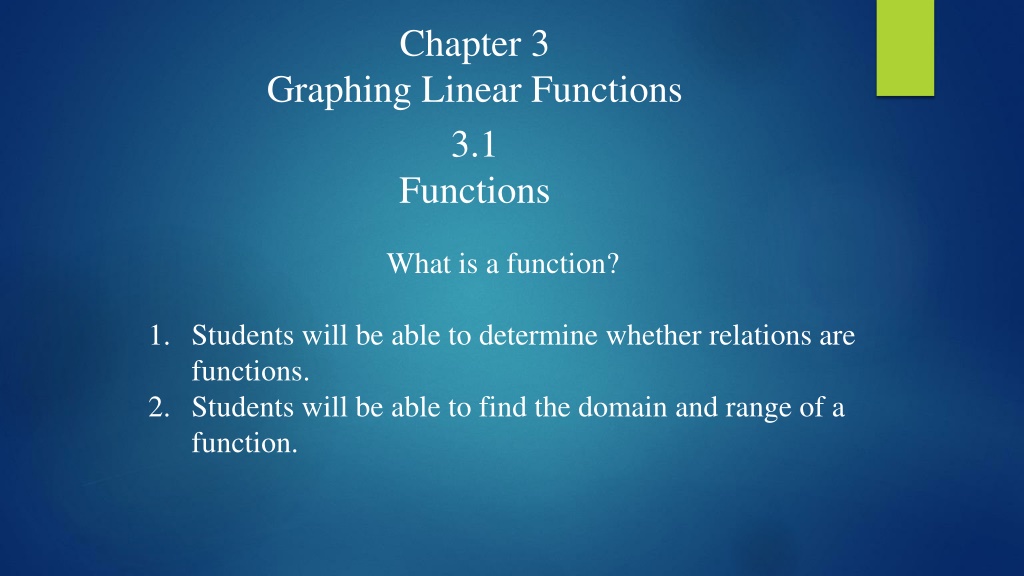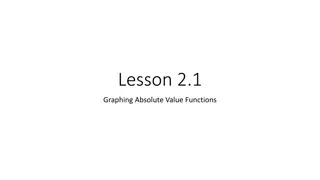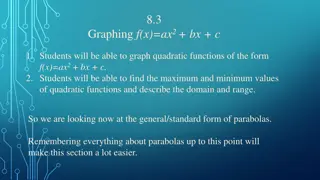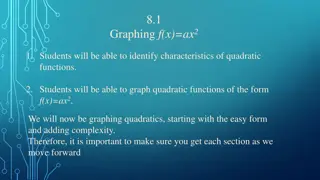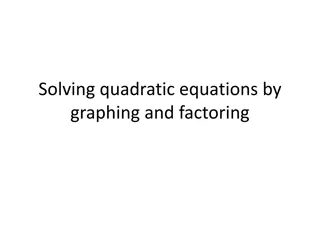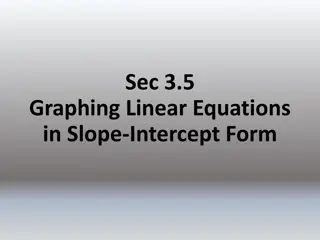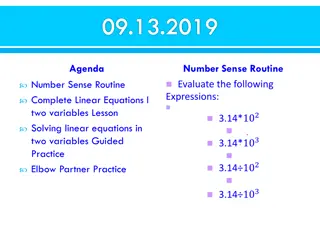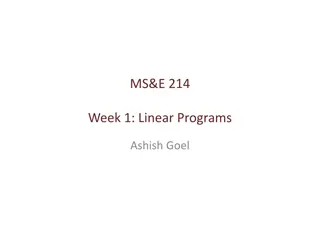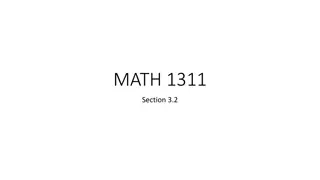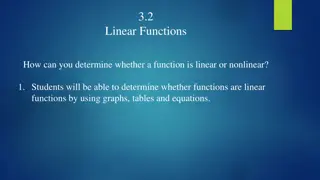Understanding Functions in Graphing Linear Functions
Students will learn how to determine if relations are functions, find domain and range, use the vertical line test to identify functions from graphs, and analyze inputs and outputs in various relations. The content covers the basics of functions, including one-to-one mappings and graphical representations.
Download Presentation

Please find below an Image/Link to download the presentation.
The content on the website is provided AS IS for your information and personal use only. It may not be sold, licensed, or shared on other websites without obtaining consent from the author. Download presentation by click this link. If you encounter any issues during the download, it is possible that the publisher has removed the file from their server.
E N D
Presentation Transcript
Chapter 3 Graphing Linear Functions 3.1 Functions What is a function? 1. Students will be able to determine whether relations are functions. 2. Students will be able to find the domain and range of a function.
1. Students will be able to determine whether relations are functions. A relation pairs inputs with outputs. When a relation is given as ordered pairs, the x-coordinates are the inputs and the y-coordinates are outputs. A relation that pairs each input with exactlyone output is a function. Determine whether each relation is a function. Explain. Each of the following is a relation. ( 2,2),( 1,2),(0,2),(1,0),(2,0) Function; each input has one output (4,0),(8,7),(6,4),(4,3),(5,2) Relation; the input 4 has two outputs Input, x Output, y -2 3 -1 4 0 5 0 6 1 7 2 8 Relation; the input 0 has two outputs
1. Students will be able to determine whether relations are functions. A relation that pairs each input with exactlyone output is a function. Determine whether the relation is a function. Explain. The following is a relation. Input Output -1 5 Function; each input has one output 3 4 11
You try!! 1. Students will be able to determine whether relations are functions. Determine whether each relation is a function. Explain. Each of the following is a relation. ( 5,0),(0,0),(5,0),(5,10) ( 4,8),( 1,2),(2, 4),(5, 10) Relation; the input 5 has two outputs Function; each input has one output Input, x Output, y Input, x Output, y 2 4 6 -2 2.6 5.2 7.8 1 2 0 Function; each input has one output 4 Relation; the input 1 2 has three outputs
1. Students will be able to determine whether relations are functions. We can also use the vertical line test (VLT) to determine if the graph of a relation is a function. A graph represents a function when no vertical line passes through more than one point on the graph Function Passes VLT Relation Fails VLT
You try!! 1. Students will be able to determine whether relations are functions. Determine whether the graph of the relation is a function. Explain. The following graphs are relations. Relation; you can draw a vertical line through (2,2) and (2,5) And (5,1) and (5,5) Function; no vertical lines can be drawn through more than one point on the graph. Function; no vertical lines can be drawn through more than one point on the graph. Relation; you can draw vertical lines through two points in several places.
2. Students will be able to find the domain and range of a function. Domain: is the set of all possible input values (x-values) Range: is the set of all possible output values (y-values) Inputs ( 3, 2),( 1,0),(1,2),(3,4) Outputs Write the ordered pairs. Identify the inputs and outputs. The domain is -3, -1, 1 and 3. The range is -2, 0, 2 and 4.
2. Students will be able to find the domain and range of a function. Domain: is the set of all possible input values (x-values) Range: is the set of all possible output values (y-values) Identify the x- and y-values represented by the graph. y-values Range x-values Domain 2 3 x The domain is 1 2 y The range is
You Try!! 2. Students will be able to find the domain and range of a function. Domain: is the set of all possible input values (x-values) Range: is the set of all possible output values (y-values) Inputs ( 2,4),( 1,2),(0,0),(1,2),(2,4) Outputs Write the ordered pairs. Identify the inputs and outputs. The domain is -2, -1, 0, 1 and 2. The range is 0, 2 and 4.
You try!! 2. Students will be able to find the domain and range of a function. Domain: is the set of all possible input values (x-values) Range: is the set of all possible output values (y-values) Identify the x- and y-values represented by the graph. y-values Range x-values Domain 1 5 x The domain is 0 4 y The range is
So lets review! What have we covered so far? 1. Students will be able to determine whether relations are functions. What makes a relation a function? A relation that pairs each input with exactlyone output is a function. What can we use? The VLT! 2. Students will be able to find the domain and range of a function. What is Domain? Domain: is the set of all possible input values (x-values) What is Range? Range: is the set of all possible output values (y-values)
